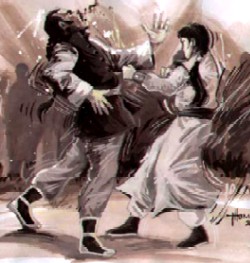About
From the past to the present
Wing Tsun history
A history of the martial art.
Wing Tsun history
Wing Tsun (commonly translated as beautiful springtime
or springtime song
) is a Southern Chinese martial art and is believed to be over 300 years old. Its originator, the Buddhist abbess Ng Mui, was a master of Shaolin Kung Fu and used this knowledge to invent a way to take advantage of the weaknesses inherent in the other Shaolin systems.
While the origins of the art of Wing Tsun (also known as Wing Chun or Ving Tsun) are lost in the mists of history, one telling of the legend is that the art was created by the Buddhist Abbess Ng Mui. During the Ching Dynasty, the Shaolin Temple was a refuge for the loyalists of the prior Ming Dynasty who sought to overthrow the Ching and restore the Ming.
The Shaolin Temple also took in lay-disciples and taught them the temple's martial art systems in a bid to aid the loyalists' cause.
Concerned by this, the Imperial Court dispatched agents to infiltrate the Shaolin Temple and learn its martial arts systems. When these agents attained mastery, they poisoned the monks and burnt down the Shaolin Temple. In the resulting carnage, only a handful escaped. The Abbess Ng Mui was one of 5 elders who escaped.
Ng Mui knew that the traitors of the Shaolin Temple had mastered its arts and that despite her own skill and mastery, she also knew that she would be no match for their youth, strength and speed. In order to counter these traitors, Ng Mui created a new martial art that would be effective against stronger opponents. To aid the rebel cause, she also designed it so that it could be learnt in a relatively short period of time.

Legend has it that Ng Mui's first disciple of this fighting system was a woman named Yim Wing Chun who used it to fight and defeat the local bully who tried to force Wing Chun to marry him. She eventually taught this fighting system to her husband Leung Bok Chau who named the art after her.
The system was eventually passed down to 2 performers belonging to the Red Boat opera troupe; Wong Wa Bo and Leung Yee Tai. These 2 masters had very different body shapes and temperaments. As such their manifestation of this art was very different. Their student, a skilled physician named Leung Jan benefited from this and became known as a skilled fighter in Foshan, Guangdong.
One of Leung Jan's top students was Chan Wah Soon who had many students. In his seventies, he taught a young man named Yip Man, who continued training with Chan Wah Soon until his passing.
Yip Man moved from to Hong Kong to study where he was involved in many fights with his European schoolmates. One day, he challenged an older man, reputed to be a skilled fighter, and was soundly defeated. This man was Leung Jan's son, Leung Bik.
Yip Man continued his training with and learned the entire system from Leung Bik. Yip Man returned to Foshan but eventually went back to Hong Kong after the Second World War. In 1949, Yip Man started teaching Wing Chun to the public and taught many students until he passed on in 1972.
History continues to be created as Yip Man's martial-art descendants and practitioners forming lineages from China make their mark in the Wing Chun community.
Clubs affiliated with WWTC
This section, provides information and links to schools we are affiliated with.
Directions to Club with Google Maps
Directions to our club are given in this section.
Pending.